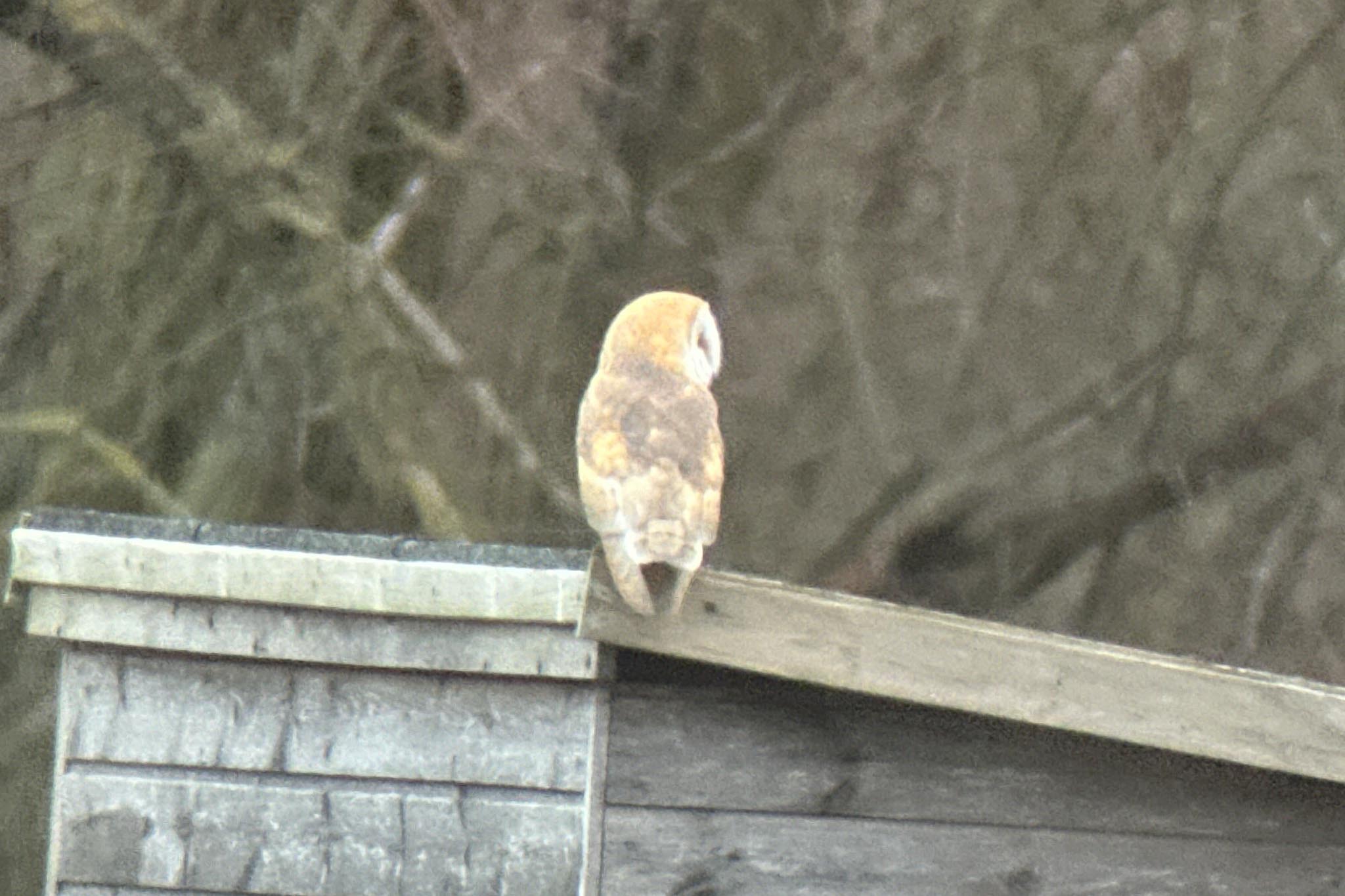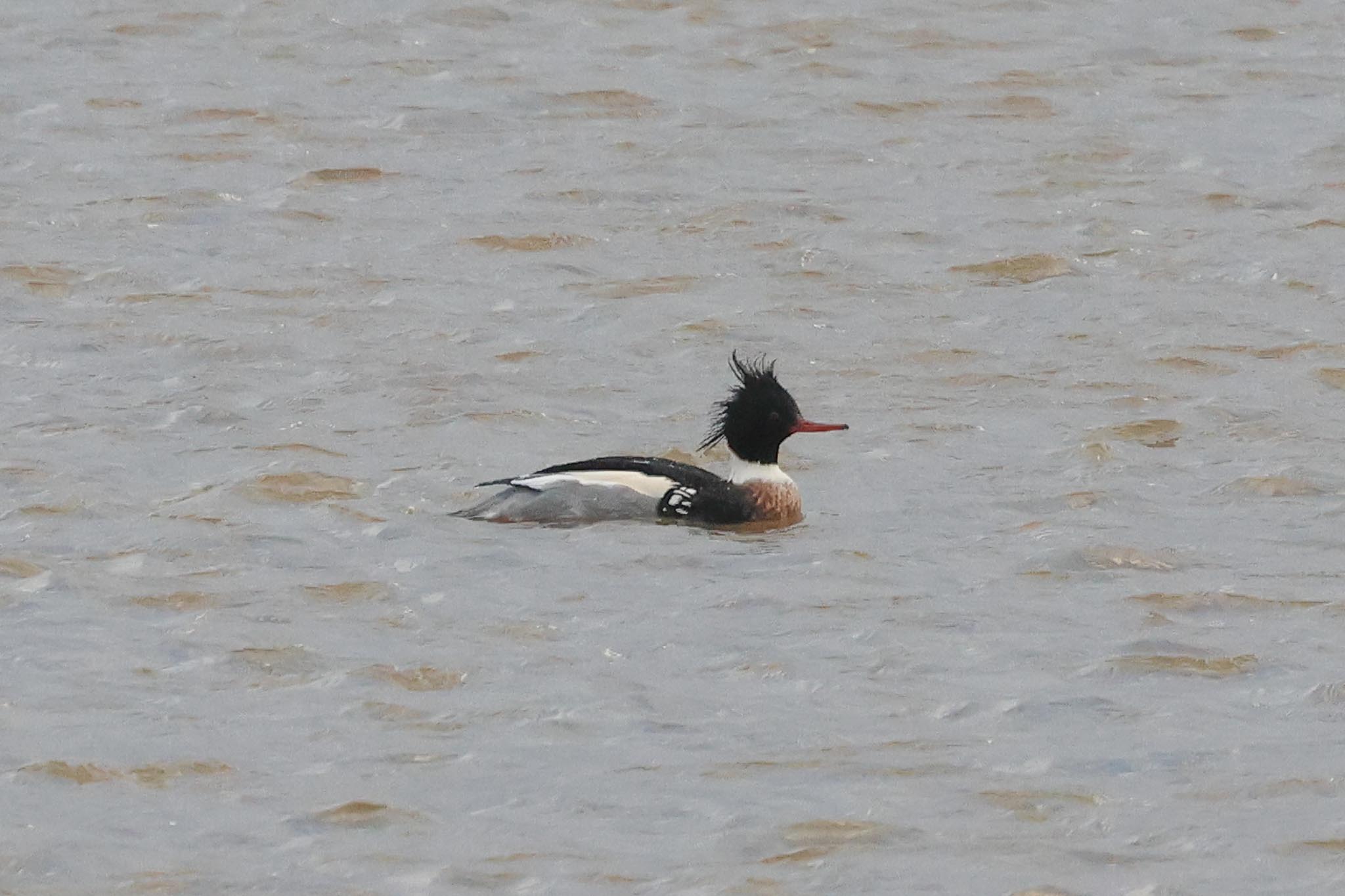Day 3 of a 3-day Winter & Owls Tour. It was mostly cloudy but dry today, but with a biting cold and blustery NE wind, which didn’t help. We spent the day back up on the North Norfolk coast.
On our way up to the coast, we stopped for a quick look for Little Owls. There was no sign of them this morning on their usual barns, but it was still dull and cold exposed to the wind. A Barn Owl was hunting the field opposite, and landed in a tree by the road, so we found somewhere to pull over and got out. It resumed its circuit of the field, then landed on an old shed over the far side. It kept dropping down off the rook into the field and back up again, presumably listening for prey in the vegetation below. A Raven flew over the trees beyond calling, and landed in the oaks by the road behind us. We could hear it kronking before it flew off south.

We dropped down to Wells and parked in the beach car park. It was cold in the wind as we walked up past the lifeboat station and started to scan the harbour. There were a few waders along the near edge of the channel – a couple of Bar-tailed Godwits, a Grey Plover flew in flashing its black armpits, and further up were several Turnstones and Ringed Plover. A Common Seal surfaced in the channel briefly.

There looked to be more birds further up the channel, where possibly it was a bit more sheltered from the wind today, so we walked round a little bit. We could see at least seven Red-breasted Mergansers in the water now, though they were diving continually. Eventually we all got good views in the scope.

A large group of Shelduck was roosting on the sandbank further up, and next to them was a flock of Oystercatchers too. Looking more closely, in amongst the Oystercatchers there was a smaller tight flock of sleeping Knot, at least until a Common Buzzard flew over and spooked them. There were more waders the other side of the channel from here, on the wet sand – more groups of Knot, lots of Dunlin, Grey Plover, Ringed Plover, Turnstone, Bar-tailed Godwit and Redshank. There is usually a Greenshank here, but we couldn’t see it at first. Then we spotted it along the edge of the water further up, before it disappeared into the furrows in the sandbar between the Shelduck and Oystercatchers.
We decided to head back and get out of the wind, and walked back round via the outer harbour, where several Little Grebes were in amongst the Mallard and the boats. While we stopped to use the facilities, we checked the news. We were hoping the Red-breasted Goose might turn up again (it wasn’t seen at all yesterday), and we had hedged our bets in case we needed to head back east, but there was no news so we set off over to Snettisham.
There were lots more Barnacle Geese in the field by the road at Holkham, but there was nowhere to pull in and having seen a few the other day we didn’t stop. Beyond Docking, we found a huge flock of Pink-footed Geese feeding in a recently harvested sugar beet field. Again, there was nowhere to stop and the beet was piled along the near edge of the field, but we had a quick scan through part of the flock from the far end and couldn’t immediately see anything different. When we got to Snettisham, we had a chance to check our messages and noticed that the Red-breasted Goose had been seen at Warham just after we had left Wells. Frustrating!

Snow Buntings have been rather thin on the ground here this winter, but there has been a flock of around 30 along the beach between Snettisham and Heacham, so we walked out to see if we could find them. The initial omens were not good – there were lots of dogwalkers on the beach and lots of loose dogs haring up and down. We walked down towards the sailing club and a Sparrowhawk flew in up the beach carrying a small wader in its talons.
Just beyond the sailing club, we met a couple of local birders there who said they hadn’t seen any sign of any Snow Buntings. Another couple of birders walked past and said they had been here for 1 1/2 hours, walked a mile and a half up and down the beach and not seen anything. Apparently, seven had earlier flown south towards the RSPB reserve, but it was too far to walk for us now from here.
The tide was out, but we had a quick scan out over the mud of the Wash. We could see lots of Oystercatchers, Bar-tailed Godwits and a couple of Grey Plovers. A flock of Golden Plover got up from the mud and some larger flocks of Dunlin and Knot whirled round in front of us, though we couldn’t see what had spooked them. There were lots of Wigeon out on the edge of the water, in the distance.

We moved on. There had been no reports of the Black-throated Diver at Holme for a couple of days, but we thought we would pop in quickly to double check, as it had been very obliging. There were a few Wigeon and Teal on the saltmarsh channel it had been frequenting, and a couple of Curlew on the edge, but no sign of the diver. We had a quick look out at the beach – there were a few more waders on the sand, Oystercatchers, Sanderling and Bar-tailed Godwits.
It was time for lunch, and we were heading to Titchwell, when we got a message to say the Red-breasted Goose had been seen in a field inland. It was quite a drive from here, so we decided to stop for lunch and a chance to use the facilities at Titchwell, and then head over to try to find it.
When we got to the fields where the Red-breasted Goose had been seen, we could see a few Brent Geese, but not the whole flock. The flock had fractured, apparently having been flushed by the farmer, and we could see another large group in the distance to the north. Even looking at the closer geese, some were in a dip in the ground and we couldn’t see all of them. After scanning through those we could see, we drove on, only to find a third group in the next field along which were even harder to see!
We drove round and found the flock further north, but all we could see were Brent Geese here, so we headed back to check out the first two groups again. By looking over the hedge from a strategic spot, we managed to see most of the geese in the first field. We were just about to drove along and have another go to look at the Brents in the second field when they were flushed by a dog walker walking along the field edge. They looked like they would land with the first group – half dropped down here, but out of view over the back of the field, and half went over to join the group to the north.
We drove back round to check the flock to the north again, but again all we could see were Brent Geese. We did pick out a Pale-bellied Brent in with the Dark-bellied Brents now, which had obviously flown in, but still no sign of the Red-breasted Goose.
Time to move on. As we were nearby, we had another quick look to see if the Little Owls were out, then headed back east. As we were driving along inland, we caught a glimpse of an owl over a gate by the road – it looked like a Short-eared Owl. We pulled up and got out, walking down to the gate. At first there was no sign of it, but after a minute it came up again out of the long grass, and we watched it flying round and round over the field. A nice bonus – we had done very well for Short-eared Owls this weekend.
We thought we had a brief glimpse of a Barn Owl, disappeared through the bushes into the next field along, but it didn’t reappear. Back in the minibus, as we drove on, we looked over the hedge and there was a Barn Owl. There is nowhere to stop here, but as we drove on slowly, the Barn Owl came closer and closer to the edge of the field until it was flying right alongside us. Then a second Barn Owl appeared, and the two of them whirled away back behind us down the field.
We wanted to have a last go for the Tawny Owl which we had only seen briefly two days ago. It usually emerges at dusk, so we made our way over there and walked out along the footpath just as the sun was starting to set. We stood just off the footpath on the edge of the trees and waited. We didn’t have to wait too long until the Tawny Owl popped up at the entrance to its hole, but unfortunately it heard us and after only a couple of seconds it dropped straight back in. It has done this before – it was still too early for it to actually leave its hole – but usually comes up again after 10-15 minutes, so we continued our vigil.
Not long after, a male Tawny Owl hooted once from the trees behind. Over the following minutes it gradually began to hoot more, great to stand and listen to, but there was still no sign of anything at the hole. We were standing facing in to the wind, which still had a bite to it, and with cloudy conditions the light started to go quickly. The Tawny Owl in its hole was obviously in no hurry to emerge and once we got past the point where we would normally expect to see it come out, we decided it was time to call it a night.
The weather had not been particularly kind to us this weekend, but we had made the most of it and seen some good birds, as well as a nice selection of owls, not least the Short-eared Owls which would live long in the memory.
















